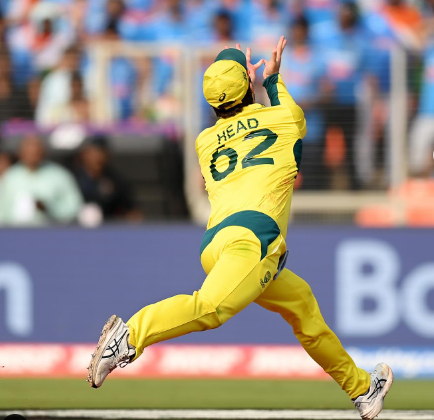Australia’s skipper hailed the ODI World Cup win as the pinnacle of his career, a moment destined to remain etched in memory. Pat Cummins and the Australian team faced a daunting year, beginning with a valiant Test series defeat in India and culminating in a glorious World Cup triumph in the same country. Along the way, they claimed the title of Test world champions and retained the Ashes in England.

Cummins expressed no uncertainty in considering the sixth World Cup triumph, achieved against formidable odds in the final against hosts and arch-rivals India, as the “pinnacle” of their achievements.
“That’s huge, I think that’s the pinnacle of international cricket, winning a one-day World Cup,” Cummins reflected shortly after Glenn Maxwell secured an emphatic six-wicket victory in Ahmedabad.
“Especially over here in India, in front of a crowd like this. Yeah, that’s huge. Yeah, it’s been a big year for everyone, but our cricket team has been here in India, Ashes, World Test Championship, and to top it off with this is just huge. These are the moments that you’ll remember for the rest of your life.
“You only get a shot at it every four years. Even with a ten-year career, you might only get two chances at it. And yeah, it’s just the whole cricket world stops with this World Cup. So it doesn’t get any better.”
Cummins had articulated his intention to silence the massive crowd, a goal his team achieved resoundingly throughout the day. Initially, their bowlers stemmed the flow of boundaries during India’s powerplay and then remarkably restricted them to four boundaries in the last 40 overs of the innings. When Australia batted, Travis Head’s boundary count surpassed that of the Indian batting order, effectively muting the noise generated by the overwhelming 90,000-strong predominantly Indian fanbase.

Despite admitting to feeling nervous before the game, Cummins demonstrated remarkable composure when the match commenced. His nerveless demeanor was evident in his decision-making – opting to bowl first against the tournament’s most formidable batting lineup and subsequently displaying his abilities with the ball.
While Cummins hadn’t performed at his peak with the ball throughout the tournament, he saved his finest performance for the most crucial stage. Dismissing Virat Kohli in the 29th over marked a pivotal moment that significantly silenced the crowd.
Reflecting on the atmosphere, Cummins acknowledged the unusual hush that befell the crowd during the game. He emphasized that it seemed like a day tailor-made for Kohli to secure another century, making the achievement even more satisfying.
As captain, Cummins tactically managed his bowlers, constantly rotating them with frequent one-over spells, which unsettled India’s batting rhythm. By the 30-over mark, Australia had made 14 bowling changes, a joint record for this World Cup. Two significant leadership choices stood out: persisting with Travis Head in the squad despite his initial injury sidelining him for the first five games and maintaining Marnus Labuschagne in the playing XI. Head’s pivotal 137-run contribution in the final and Labuschagne’s unbeaten 58 in their partnership of 192 underscored the wisdom behind these decisions. Labuschagne’s consistent presence throughout the tournament raised concerns about Australia’s scoring rate in the middle overs, yet his performance proved invaluable.
Expressing their team’s approach, Cummins emphasized their intent to be bold and aggressive in the World Cup. They aimed to avoid a cautious entry into the semifinals and sought to assert themselves by setting high targets, exemplified by the batting order’s aggressive composition with players like Warner, Marsh, and others. Cummins also praised Labuschagne’s adaptability and skill, noting his exceptional performance in South Africa that warranted his inclusion despite a different playing style from the start of his ODI career. Ultimately, Cummins acknowledged Labuschagne’s undeniable talent, emphasizing the importance of accommodating such an asset in the team.
Post the critical injury to Travis Head, Cummins, and the team had initially believed that Head’s World Cup journey had ended. However, the decision to retain him emerged only the night after the injury, when coach Andrew McDonald approached Cummins with a sleepless night behind him, expressing that retaining Head might prove pivotal. McDonald’s belief centered on Head’s potential recovery for the Netherlands match and his necessity for the team’s prospects in the finals.
At the onset of the World Cup, Cummins had a relatively limited exposure to ODIs, having played only two matches since November 2022 and eight since November 2020. Despite this, he voiced his rediscovered passion for the format during the tournament, advocating for more high-stakes games in the future. The fate of ODIs is anticipated to be deliberated upon at the ongoing ICC Board meetings in Ahmedabad; however, any concrete decisions remain uncertain.
Cummins expressed his sentiments and highlighted his newfound appreciation for One Day International cricket, particularly due to the significance of every match in a tournament setting. He emphasized how this differs from bilateral series and spoke fondly of the World Cup’s historical significance and the many remarkable games and stories it has produced.
While acknowledging its rich legacy, Cummins remained optimistic about the enduring relevance of the World Cup, recognizing its enduring significance within the cricketing landscape.
If you’ve enjoyed the insights and strategies discussed in “Silencing the Crowd: Cummins’ Ultimate World Cup Strategy,” I invite you to dive even deeper into the world of cricket strategies and analyses on my YouTube channel.
🏏 Click here to visit our YouTube Channel 🏏